Related Research Articles
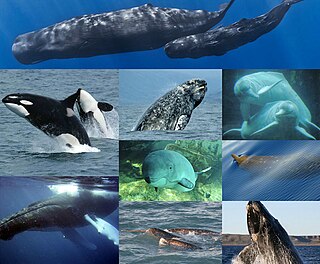
Cetaceans are an infraorder of aquatic mammals belonging to the order Artiodactyla that includes whales, dolphins, and porpoises. Key characteristics are their fully aquatic lifestyle, streamlined body shape, often large size and exclusively carnivorous diet. They propel themselves through the water with powerful up-and-down movement of their tail which ends in a paddle-like fluke, using their flipper-shaped forelimbs to maneuver.

Marine mammals are mammals that rely on marine (saltwater) ecosystems for their existence. They include animals such as cetaceans, pinnipeds, sirenians, sea otters and polar bears. They are an informal group, unified only by their reliance on marine environments for feeding and survival.
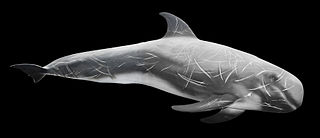
Risso's dolphin is a dolphin, the only species of the genus Grampus. Some of the closest related species to these dolphins include: pilot whales, pygmy killer whales, melon-headed whales, and false killer whales.

Sowerby's beaked whale, also known as the North Atlantic or North Sea beaked whale, is a species of toothed whale. It was the first mesoplodont whale to be described. James Sowerby, an English naturalist and artist, first described the species in 1804 from a skull obtained from a male that had stranded in the Moray Firth, Scotland, in 1800. He named it bidens, which derives from the two teeth present in the jaw, now known to be a very common feature among the genus.
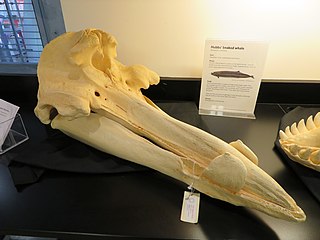
Hubbs' beaked whale was initially thought to be an Andrews' beaked whale when discovered by ichthyologist Carl Hubbs; however, it was named in his honor when it was discovered to be a new species. This species has the typical dentition found in the genus, but its main outstanding features are a white "cap" on the head and very extensive scarring. The species is known from 31 strandings, a few at-sea sightings, and observations of two stranded whales that were kept in captivity for 16–25 days.

The long-finned pilot whale is a large species of oceanic dolphin. It shares the genus Globicephala with the short-finned pilot whale. Long-finned pilot whales are known as such because of their unusually long pectoral fins.

The Cuvier's beaked whale, goose-beaked whale, or ziphius is the most widely distributed of all beaked whales in the family Ziphiidae. It is smaller than most baleen whales yet large among beaked whales. Cuvier's beaked whale is pelagic, inhabiting waters deeper than 300 m (1,000 ft). It has the deepest and longest recorded dives among whales at 2,992 m (9,816 ft) and 222 minutes, though the frequency and reasons for these extraordinary dives are unclear. Despite its deep-water habitat, it is one of the most frequently spotted beaked whales.

The false killer whale is a species of oceanic dolphin that is the only extant representative of the genus Pseudorca. It is found in oceans worldwide but mainly in tropical regions. It was first described in 1846 as a species of porpoise based on a skull, which was revised when the first carcasses were observed in 1861. The name "false killer whale" comes from having a skull similar to the orca, or killer whale.

The pygmy killer whale is a poorly known and rarely seen oceanic dolphin. It is the only species in the genus Feresa. It derives its common name from sharing some physical characteristics with the orca also known as the killer whale. It is the smallest cetacean species that has the word "whale" in its common name. Although the species has been known to be extremely aggressive in captivity, this aggressive behavior has not been observed in the wild.

The melon-headed whale, also known less commonly as the electra dolphin, little killer whale, or many-toothed blackfish, is a toothed whale of the oceanic dolphin family (Delphinidae). The common name is derived from the head shape. Melon-headed whales are widely distributed throughout deep tropical and subtropical waters worldwide, but they are rarely encountered at sea. They are found near shore mostly around oceanic islands, such as Hawaii, French Polynesia, and the Philippines.

Cetacean stranding, commonly known as beaching, is a phenomenon in which whales and dolphins strand themselves on land, usually on a beach. Beached whales often die due to dehydration, collapsing under their own weight, or drowning when high tide covers the blowhole. Cetacean stranding has occurred since before recorded history.

The Tethys Research Institute is a non-profit research organisation founded in 1986 to support marine conservation through science and public awareness and by participating in the international conservation process. Tethys' activities are mainly carried out in the Mediterranean Sea, although research programmes have been conducted also in the Black Sea, the North Atlantic Ocean, the Caribbean, the Red Sea and Antarctica. The results of these activities have been presented in scientific publications as well as in meetings, workshops and conferences.
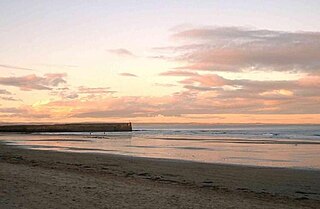
The Gatty Marine Laboratory is a science facility located in the coastal town of St Andrews in Fife, Scotland. It is part of the University of St Andrews and home to the Scottish Oceans Institute, an interdisciplinary research institute studying the marine environment, specifically the behaviour, ecology, physiology, population biology and functional genomics of marine organisms. The Gatty Marine Laboratory is known as the place where Richard G. Morris developed the Morris water navigation task in the early 1980s.


The interactions between marine mammals and sonar have been a subject of debate since the invention of the technology.

Sir Ian Lamont Boyd, is a Scottish zoologist, environmental and polar scientist, former Chief Scientific Adviser at the Department for Environment, Food and Rural Affairs (DEFRA) and is a professor of biology at the University of St Andrews. He is Chair of the UK Research Integrity Office and President of the Royal Society of Biology.
Kit Kovacs is a marine mammal researcher, best known for her work on biology, conservation and management of whales and seals. She is based at the Norwegian Polar Institute (NPI), Tromsø and is an Adjunct professor of biology, Marine Biology, at the University Centre in Svalbard (UNIS).
Cetaceans form an infra-order of marine mammals. In 2020, approximately 86 species of cetaceans had been identified worldwide. Among these species, at least 35 have been sighted in the wider Caribbean region with very widespread distribution and density variations between areas. Caribbean waters are a preferred breeding site for several species of mysticeti, who live further north the rest of the year. The tucuxi and the boto live at the southern periphery of the Caribbean region in the freshwaters of the Amazon river and surrounding drainage basins.
Ailsa Jane Hall is a British researcher who is Director of the Sea Mammal Research Unit at the University of St Andrews. Her research considers the impact of contaminants on the risk of mortality in marine mammals.
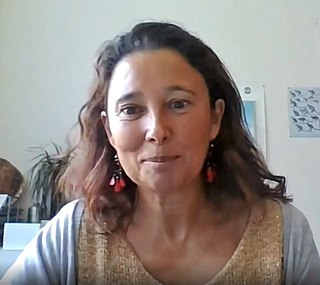
Natacha Aguilar de Soto is a Spanish marine biologist at the University of La Laguna (ULL), Tenerife, Canary Islands. She is a Ramón y Cajal research and teaching fellow at ULL and has been a Marie Skłodowska-Curie Research Fellow at ULL and at the Center for Research in Ecological Modeling (CREEM) of the University of St. Andrews (SMRU). She is the director of cetacean research within ULL's BIOECOMAC.
References
- ↑ "Archived copy" (PDF). Archived from the original (PDF) on 24 January 2012. Retrieved 15 March 2013.
{{cite web}}: CS1 maint: archived copy as title (link) - ↑ "Sea Mammal Research Unit". Archived from the original on 16 March 2008.
- ↑ "NERC - Sea Mammal Research Unit". Archived from the original on 10 May 2007.
- ↑ admin. "Home". SMRU Consulting. Retrieved 6 May 2019.
- ↑ "Generation of the sea – Where life originated". seageneration.co.uk. Retrieved 6 May 2019.
- ↑ "Passive Acoustic Marine Mammal Monitoring Data Acquisition". www.sa-instrumentation.com. Retrieved 6 May 2019.
- ↑ "Scottish Marine Animal Strandings Scheme". www.facebook.com. Retrieved 6 May 2019.
